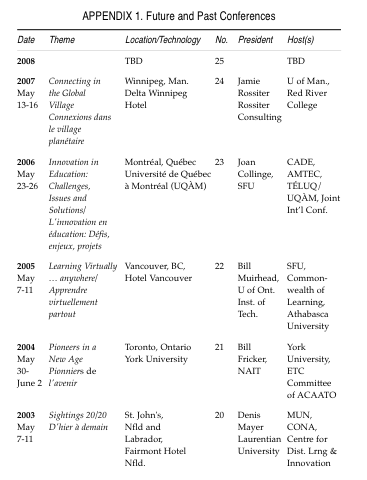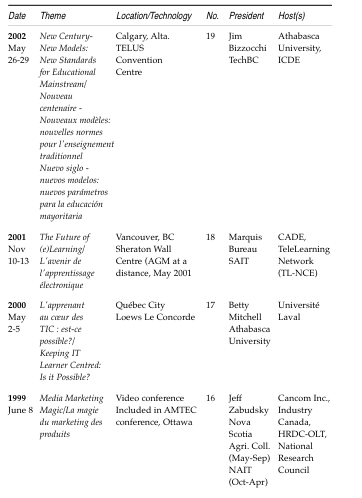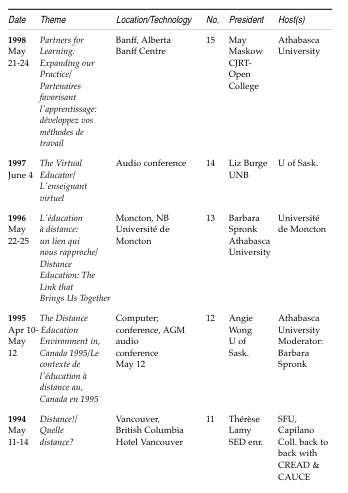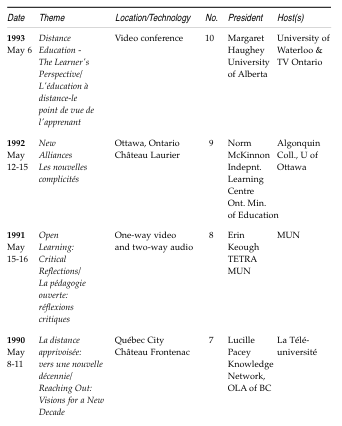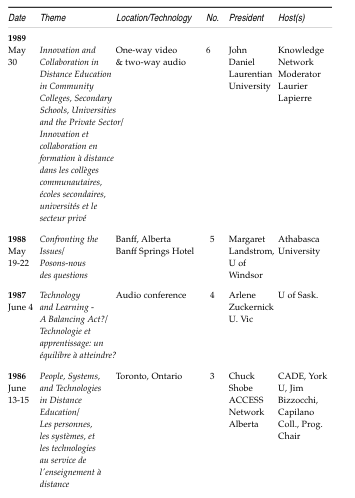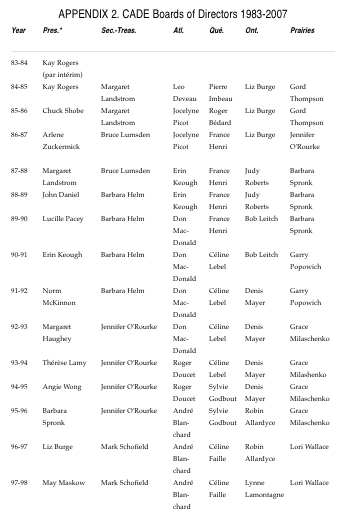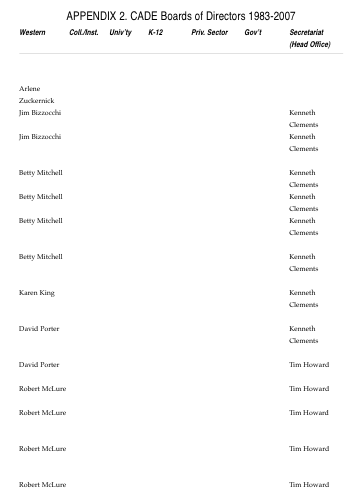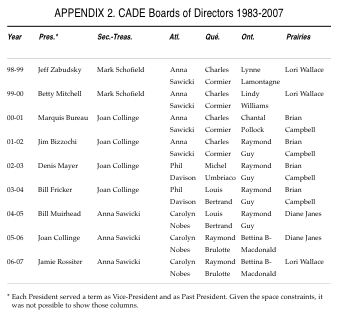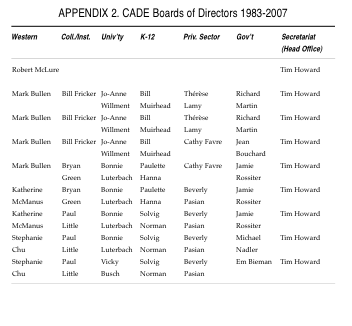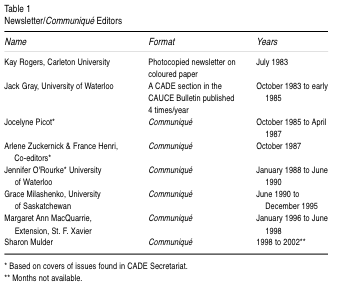
CADE: Looking Forward by Glancing Back |
VOL. 21, No. 3, 167-213
On April 1, 1983, thirteen “enthusiastic, daring, creative and resourceful” (Landstrom, 1993, p. 113) Canadian distance educators who were attending an international conference on telecourses gathered in a hotel room in Washington DC to socialize. They left that evening with a dream: a Canadian distance education association. Now, after the memberships of both CADE and the Association for Media and Technology in Education in Canada (AMTEC) have voted to create a new national bilingual organization based on a reformulated vision, CADE is once again moving forward into a new and exciting future. And so, it seems timely to reflect upon where we have been as we envision where we might go. In February 2006, the Board of Directors commissioned a paper celebrating and documenting CADE’s past using a combination of interview and document research techniques. The paper describes CADE’s evolution in five sections: (1) mandate and services, (2) organization and finances, (3) Francophone perspectives, (4) CADE internationally, and (5) The future. In one sense, CADE has succeeded beyond the wildest dreams of that visionary band who met in a hotel room in Washington DC in 1983. Blended learning is now seen as conventional, accepted practice by many stakeholders. In another sense, blended and flexible learning are perceived as becoming so dominant that the need for, and values of, distance educators are being lost. We join many quoted in this paper in cautioning that adopting DE practice in an a historical context can mean failure not success, especially if values and practice are not aligned.
On April 1, 1983, thirteen “enthusiastic, daring, creative and resourceful” (Landstrom, 1993, p. 113) Canadian distance educators who were attending an international conference on telecourses gathered in a hotel room in Washington DC to socialize. They left that evening with a dream: a Canadian distance education association. Landstrom listed those dreamers and described how that dream was realized little more than a year later. Successive ten- and twenty-year reports stress the “ positive attitude and … willingness to learn, to risk, to try new methods and new ideas, and to believe that new things are possible” (Landstrom, p. 117) and the commitment of leaders, volunteers, staff and institutions evidenced by the work that the Canadian Association for Distance Education/l’association canadienne de l’éducation à distance (CADE) performs each year (Annual Report, 2002-03).
Being President of CADE-ACED during the 20th anniversary year was especially meaningful and gratifying for me. I was fortunate to work with a strong board of committed and dedicated members who provided support and encouragement that moved the organization forward during this milestone year.
I attended my first CADE-ACED conference just a few months after joining Laurentian University in 1988. The meeting was in Banff that year and I was introduced to so many delightful and passionate people in this field. This organization has had considerable influence on my career in higher education.
Personal communication, March 18, 2006
Denis Mayer, President, 2002-03
From its inception, CADE has been committed to several cornerstone values and principles:
It was a shoestring operation, but there was a commitment from the beginning to be national and bilingual, inclusive of all sectors and to adopt CAUCE's model of an organization with a Secretariat and [to be] an organization that partnered with others.
Personal communication, March 19, 2006
Arlene Zuckernick, President 1986-87
Now, after the memberships of both CADE and the Association for Media and Technology in Education in Canada (AMTEC) have voted to create a new national bilingual organization based on a reformulated vision, CADE is once again moving forward into a new and exciting future. And so, it seems timely to reflect upon where we have been as we envision where we might go.
In February 2006, the Board of Directors commissioned this paper to celebrate and document CADE's past using a combination of interview and document research techniques within a short time period. Two people with a long history of involvement in CADE were engaged. They asked all twenty-two past and current presidents two questions:
Each was also asked to provide a direct quotation for this paper. Twenty replied in a 15-20 minute telephone interview and two replied by email. Six international colleagues were also contacted; four replied and were interviewed by telephone.
Additional research was undertaken to summarize the views of CADE's Francophone membership. In March 2006, we asked about twenty francophone members (some were presidents of CADE, others were intimately committed to its development and still others were members who “lived the CADE experience”) what they really thought of Landstrom's declaration (1993), what CADE represented for them in the past and how they saw the organization's future. Unlike the comments made by former CADE presidents that related to the business activities of the organization, these views were more personal; individual confidentiality has therefore been protected.
Document research included a review of all annual reports. Some additional materials were located by emailing early Board members, but time precluded tracking down every possible document. Some issues of Communiqué and the Journal of Distance Education (JDE)/Revue de l'éducation à distance were consulted as resources permitted.
The balance of this paper describes CADE's evolution, relates the story behind the numbers, and speculates on what the future may hold. There are five sections: (1) mandate and services, (2) organization and finances, (3) Francophone perspectives, (4) CADE internationally, and (5) The future.
One key memory that CADE‘s first president Kay Rogers retains is how quickly the organization came together and set up almost “full blown” services to members (personal communication, May 8, 2006). The executive functioned as an editorial committee and produced photocopied copies of the minutes of the inaugural June 15, 1983 audioconference, a draft constitution, and contributed content to a CADE section in the Canadian Association of University Continuing Education (CAUCE) newsletter. Liz Burge, from the Ontario Institute for Studies in Education (OISE), immediately organized professional development (pro-d) sessions. Dawn Howard, supported by Simon Fraser University, came forward with a proposal for a journal; Volume 1, Number 1 came out in Fall, 1986. Awards were also launched to recognize and promote excellence. Less than one year after the inaugural meeting, 212 people had completed a form expressing interest in an association. The need for a logo was identified in a July 1984 letter to members from then President Kay Rogers. Competitions from members resulted in the initial logo, as well as new ones in 1996-97 and again in 2003-04. The following sections discuss these activities in more detail.
Two main types of professional development (pro-d) were organized: programs during the year and an annual conference. The latter always had some level of translation as resources permitted; the former was offered only in English in the first two years but moved to include French in the series‘ third year.
The first workshop was held April 25-26, 1984 on the topic of instructional design for distance educators using a combination of print, video, audioconferencing and local discussion groups (Annual Report, 1983-84). The workshop involved 18 sites and 270 attendees. Two pro-d sessions were held in May 1985, one an entry level workshop on Support Systems for Learners at a Distance (22 sites, 125 attendees), the other a session for experienced practitioners on Using Computers in Distance Education (13 sites, over 80 people). Céline Lebel from the Télé-université offered the first French-language event, Le tutorat comme mode de support à l'apprentissage à distance (Annual Report, 1986-87).
These first pro-d sessions described in the annual reports for 1983-84, 1984-85 and 1985-86 submitted by Kay Rogers do not mention a specific committee that organized these sessions but by 1987, a formal Research and Development Committee was assigned responsibility for pro-d. The Committee organized four audioconference sessions (Annual Report, 1986-87), one the following year (Annual Report, 1987-88) and four more in 1989, as well as events such as a pre-conference workshop in Merrickville, Ontario before the 1992 conference in Ottawa (personal communication, Margaret Haughey, July 1, 2006). In 1992-93, research was separated from pro-d; a co-chair model was adopted for the Pro-d Committee, with Henriette Dauphinais taking responsibility for two Francophone activities and Debbie Ball for six Anglophone programmes. In March 1993, a 26-site audioconference session was held in French; another programme was organized in April. However, that committee no longer reported on its work by 1996-97.
The pro-d activities were “branded” as Wise and Witty Wednesdays (WWW) (Annual Report, 1996-97). After a successful year in which an average of 100 people across 15 sites participated in each of eight events, the series became erratic until it resumed in October 2001 as Wise & Witty Weekdays (W&WW); six audioconference sessions were organized that year (Annual Report, 2001-02). A series subscription rate and marketing tools were introduced that year to boost participation. The audioconference series has continued on a regular basis under Bill Fricker's leadership, with the addition of an ASYNCH session moderated by Barbara Spronk (Annual Report, 2002-03), and the launch of online Virtual Vendors Venue sessions (Annual Report, 2003-04). In June, 2004, Bill reported that the Committee had organized eight (8) W&WW audio sessions, five (5) ASYNCH Online Discussions and two online Virtual Vendors' Venue sessions. In May 2006, nine W&WW sessions were reported for the 2005-06 year; Elluminate technology and AMTEC's audio archiving service were used in each of two separate sessions (Annual Report, 2005-06).
Another professional development service offered was an annual conference (see Appendix 1):
CADE conferences are both splendid and special. I particularly recall those held in grand locations like the Banff Springs Hotel, Chateau Frontenac and Hotel Vancouver. They featured outstanding keynote speakers, first sightings of new technologies, input from world renowned research gurus and innovative exhibits. But the special part was seeing people debunk my assumption that if distance education was good enough, face to face interactions didn't really matter. Seeing a student actually meet a professor whom he/she had taken a course from online, classmates laying eyes on each other for the first time, and absorbing off-the-cuff reactions from world class researchers in cracker barrel sessions are just some examples of what happens at CADE conferences that makes them delightful people-to-people events that go well beyond meeting to further a professional interest.
Personal communication, April 26, 2006
May Maskow, President, 1997-98
At first a responsibility of almost the entire board, in 1987-88, a Professional Development Committee was given responsibility for organizing the conference program held that year in Banff. Later, a separate conference committee was established each year and the Pro-d Committee organized professional development (Annual Report, 1992-93). Initially alternating between in-person and distance formats, the conference has been held annually in person since 2000, primarily for financial reasons. It should be noted that all host institutions shown in Appendix 1 contributed substantial direct and in-kind resources without which the conferences could not have been held. Their support also allowed CADE to realize surpluses in many years, funding that was critical to the Association's financial health.
While CADE member organizations tend to host/co-host conferences, a number of other arrangements have also been tried. For example, the conference has been embedded in a CAUCE conference (1984) and in an AMTEC conference (1999), been scheduled sequentially with other organizations' conferences (CREAD and CAUCE in 1994), and co-sponsored (with Tele-Learning in 2001, ICDE in 2002 and COL in 2005). In 2001-02, CADE organized a half-day programme during a CANARIE conference.
From the outset, CADE has produced two publications for its members, a newsletter and a peer-reviewed journal.
In the first few years, producing photocopies of information for members, some of which was officially labeled a newsletter, seemed to be a collaborative function of everyone at the Washington meeting and members of the 1983-84 board, although the titular editor was Kay Rogers. CADE also had a section edited by Jack Gray in the CAUCE Bulletin which was published three times a year; news items were channeled to him through Liz Burge (Annual Report, 1984-85). This early history is best summarized by one of the people intimately involved:
As I went through the CADE box in the basement, I was reminded that in addition to the mailout I did on multicoloured paper, Jack Gray edited the CADE section in the CAUCE Bulletin. The CADE section in the CAUCE Bulletin of October 1983 begins with the following message from Jack Gray, the Editor:
Here is the first news from members of the embryonic Canadian Association for Distance Education. I thought of suggesting the rebellious Jack Cade as our mascot (see 2 Henry VI), but his rebellion didn't last long, and he not only starved to death, but was slain by a virtuous gentleman from Kent. Our CADE can; Shakespeare's Cade Kent.
Personal communication, May 8, 2006
Kay Rogers, President, 1984-84
Communiqué almost always had content in French; the first (and perhaps only) full translation issue was a double issue in 1997 that was also a formal printed version with professional layout and design (Annual Report, 1996-97). After a hiatus of almost two years, the first electronic issue of Communiqué was posted on the CADE website in June 2002 (Annual Report, 2001-02). Subsequently, no formal editorial structure has existed; news is posted to the website as appropriate. Perhaps, the Secretariat's use of the listserv has also, in a sense, “replaced” Communiqué. Successive editors are acknowledged in Table 1.
The second significant publication is the Journal of Distance Education (JDE)/Revue de l'éducation à distance (RED), one of the first in the world to offer scholars a peer-reviewed publication in which to share their research in this field. Only The American Journal of Distance Education 1987), the United Kingdom's Open Learning (1986) and Australia's Distance Education (1980) have a similar longevity. Of the four, JDE is the only one that has not moved to commercial publication.

Other key accomplishment by CADE — the creation of a journal as a tool to ensure that DE exists as a recognized professional activity. (People go but writing stays.)
Personal communication, April 22, 2006
Marquis Bureau, President, 2000-01
The Social Sciences and Humanities Research Council (SSHRC) has recognized JDE as a quality, peer-reviewed scholarly publication. The first three-year SSHRC grant of $7,480 p.a. was received in January 1989 (Annual Report, 1988-89); JDE applied for and was awarded another three-year grant in 2004 (Annual Report, 2003-04).
Provided at no charge to members as a service they purchase with their membership, the Journal has attracted the consistently high level of additional subscriptions from libraries and non-members shown in Table 2. The decline since 2000 can be attributed to JDE being included in commercial library data bases and being freely available on the web.
From its first issue in Spring 1987 to the 1997 Special Issue, Simon Fraser University (SFU) provided financial support for JDE ’s publication. As of 1998, when JDE moved to the University of Alberta, it has received
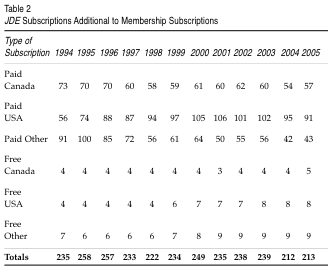
direct support from CADE. In the Spring 1998 issue, the logo changed; another redesign occurred with the Spring 2004 issue when the CADE logo changed again. In 1999-2000, SFU enabled JDE to digitize all back issues; Athabasca University hosted the electronic content on the web that same year. Each issue of JDE now appears in digital and paper format. Successive journal editors and special issue editors are listed in Table 3.
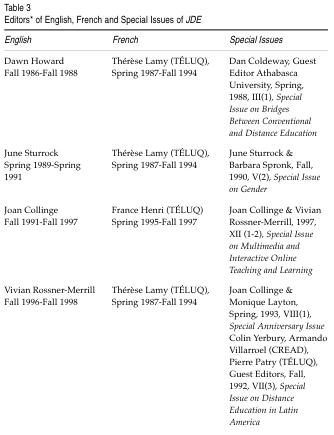
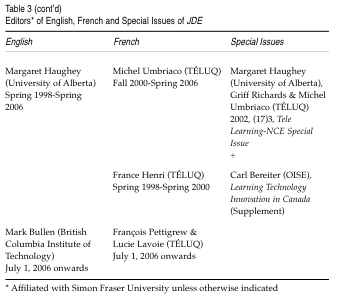
Each issue credits Associate Editors, Book Review Editors, Consulting Editors both within Canada and abroad, translators, editorial assistants, design and production staff, graphics designers, administrators, and technical editors; reviewers are acknowledged in one annual list. JDE has always published articles in French and designated an editor responsible for such articles.
Awards
The other member service that was quickly launched was a process to recognize excellence (Annual Report, 1987-88). Heather Persons' 1993-94 Awards Committee Report (the earliest found) refers to committees that served in the previous three years, supervising three award competitions (i.e., Awards were only given out at in-person conferences). She also notes the inauguration of a $25 entry fee to cover costs and the reorganization of the adjudication process. In May 2006, the Awards of Excellence Committee Report noted that 36 high calibre projects were submitted to compete for 12 awards, six in French and six in English. The six categories were instructional design, graduate research, research, partnership/collaboration, student services, and the graduate student stipend.
Government Relations
A Government Relations Committee was struck in 1984-85. Presidents such as Arlene Zuckernick (1986-87) and Margaret Landstrom (1987-88) recalled that a major focus of their presidencies was responding to requests from government, educational institutions and the private sector for information about DE and for assistance in organizing key events that used technology in hitherto unfamiliar ways.
In the year I [Margaret Landstrom] was president, … the National Forum on Postsecondary Education … was held in Saskatoon, and included presidents or AVPs from each Canadian University. …. Jeffrey Holmes, then with the feds, … approached me to involve CADE in setting up "distance sites" to discuss the same issues that were being reviewed in Saskatoon using audioconferencing …… I remember the discussions in Iqualuit took place in the dark because of an electrical failure but they still participated and reported! I think we had … about a dozen sites, arranged through ….. various CADE members who got some of their institutional leaders to participate.
In my year a few of us developed and presented to the House of Commons Standing Committee of the Secretary of State on “The Technology and Models of Post-Secondary Distance Education ”, again an event in which we used technology to demonstrate how education could be enhanced or provided using technology.
Personal communication, March 8, 2006
Margaret Landstrom, President, 1987-88
CADE also involved itself in federal government initiatives such as copyright policy, a key issue for CADE members, when an act was put before Parliament in 1992.
It seems to me [Jennifer O’Rourke] that Lori Wallace at UManitoba and Grace Milashenko at USask were also involved–we had a small committee …In April 1989, CADE [President John Daniel] presented a brief on copyright to the Department of Communications and the Ministry of Consumer and Corporate Affairs. …. [pointing] out the particular needs of distance students for access to academic materials, and urged those drafting the legislation “–to ensure that future copyright clearance procedures will be straightforward and manageable, and pose no unreasonable restrictions to access to either Canadian or international academic materials for distance students …. In response …, Communications Minister Marcel Masse noted that …. . “some of the concerns (CADE) has raised go beyond what was discussed by the Educational Committee.” As a result, the minister forwarded the brief to the departmental officials responsible for drafting the legislation.
Personal communication, May 3, 2006
Jennifer O'Rourke, Communiqué Editor 1988-90
Throughout the 1990s, CADE members were involved as individuals in a key set of federal government initiatives such as Living Well, Learning Well, the Prosperity Initiative and the Information Highway Advisory Council (IHAC), followed by Connecting Canadians. A key concern of the federal government at that time was that education was not contributing to the competitiveness of the Canadian economy, that ways had to be found to improve the situation and that technology might play a part. The fact that senior levels of government were aware of the broad concept of the use of technology in education could be seen as a positive development but there was also concern that the focus placed undue emphasis on technology to the detriment of learning and the learner. The Prime Minister's Office made technology a key priority, co-hosting with the World Bank a 1997 conference in Toronto and highlighting the issue at a G8 meeting in Alberta.
In 1995, the federal government established the Office of Learning Technologies (OLT) which had close ties with CADE. A number of Association leaders sat on OLT’s initial Advisory Committee and subsequent evaluation committees and OLT has participated regularly in CADE pro-d and conference events. On occasion, OLT has also worked with CADE on a variety of research and policy initiatives.
It should be noted that for a number of years, indeed perhaps since its inception, the CADE Board has met in person once a year, and has usually hosted one or two federal government representatives who brief the Board on relevant work being done in their departments or agencies. The federal government has consistently supported CADE’s work by taking booths at the conference trade shows, as have provincial governments when conferences occur in their jurisdiction.
Research
CADE’s aims and objectives include the promotion of research into distance education theory and practice. Since its founding, the Association has honoured this commitment in a number of ways, including striking a research committee, publishing the Journal of Distance Education and creating awards recognizing excellence in research. These efforts have met with varying degrees of success.
The Research and Development Committee's initial focus was on sharing research results with members through professional development. Later, the Committee tried to conduct modest research projects without much success because of limited resources. When the 1994 conference realized a “healthy surplus … thanks to the magnificent efforts of the 1994 CADE conference committee under the leadership of Joan Collinge and Jim Bizzocchi” (Angie Wong, Annual Report, 1994-95), efforts were made to develop guidelines for a CADE Research Fund that would be generated from a trust account. Hoped for linkages with, and matching funds from, organizations in business and industry with interests in learning and training were never realized. After 1996-97, the Research Committee no longer appeared on AGM agendas.
CADE's consultative work on the national and international stages raised the question of the Association's research capacity in a different way: i.e., how to develop the evidence on which to base policy advice and how to balance the need to respond to such requests with the mandate to focus primarily on serving members. In 1998, CADE launched an English-language national policy research centre, the Institute for Distance and Distributed Education Advancement (IDEA), hosted by the Open Learning Agency (OLA), and a competition for the host of a Francophone centre, the Institut pour la promotion de l'éducation à distance (IPÉD). Téluq was selected to host IPÉD, and did so from approximately 1999 to 2004. IPÉD completed one study funded by OLT that was presented to the APEC Education Forum in South Korea and the UNESCO conference in Moscow (Faille & Umbriaco, 1999). However, personnel changes at OLA meant that hosting IDEA had to be tendered, with no success.
Although various reports indicate CADE's continuing interest in policy research, the concept has yet to be operationalized on a sustainable basis in either English or French (Annual Report, 1999-2000; Draft Business Plan, 2004). Nevertheless, CADE undertakes research on an ad hoc basis. OLT has funded a $49,500 research project entitled, Determinants of Institutional Readiness for Distance/Distributed Learning; the final report is to be completed June 30, 2007. Kathleen Matheos, University of Manitoba, Raymond Guy, Collège Boréal, and Bonnie Luterbach, University of Manitoba, are leading this research initiative for CADE.
One concrete achievement has been the establishment of a graduate research fund. Under Joan Collinge's leadership, Simon Fraser University launched the fund with a five-year contribution of $2,000 per year, enabling the first awards to be distributed in 2005. The amount of money available for disbursement each year depends upon the sponsors' contributions to the fund. Awarded as a stipend that facilitates the conduct of graduate student research, the funds are distributed according to merit and proposed expenses. Depending on the submissions received, one award of $2,000 or several small awards of lesser amounts may be awarded. Joan worked closely with Bonnie Luterbach at the University of Manitoba to put the adjudication and award process in place.
While CADE has always put the learner and learning before technology, the use of technology has been embedded in organizational practice from the outset. The Association's use of technology in professional development and conferences, as well as in organizational management, was seen as bold and innovative; now, such practice seems commonplace.
As an early adopter, we might have been … the first national association anywhere to put … technology to such a use. In today's world of Skype and ubiquitous cell phones, teleconferencing may seem commonplace, but in the mid 80’s, we believed, as we do now that the “best way to predict the future is to invent it” (Alan Kay). And, with much trepidation and excitement, we set out to do so, not knowing what it was exactly that we were "inventing" but determined to see what we could do. I participated in the [first] meeting from the West Coast and when the meeting ended, we immediately gave a great sigh of relief and started to discuss lessons learned for the next meeting at a distance.
Personal communication, March 9, 2006
Arlene Zuckernick, President, 1986-87
Besides the use of technology in various Member Services and Government Relations activities, it is worth emphasizing that CADE held its inaugural session and first two annual general meetings, as well as all its professional development programs by audioconference from 1983 to 1985 before organizing an in-person event in June 1986.
My strongest memory of CADE is one of my earliest. As a brand-new board member in 1985, I was given the responsibility of organizing and chairing the Association's first face-to-face conference [in 1986]. I was able to do so because of the extraordinary support of two groups of colleagues (the Toronto local arrangements committee and the national program committee) who I didn't know, who I worked with for a year via audio-conferences but never saw in person, and who I met for the first time when we walked in the door at the beginning of the York University 1986 CADE Conference. This experience made clear to me the power of human intelligence and good-will to transcend technological limitations and make real the most significant shared achievements and understandings.
Personal communication, May 27, 2006
Jim Bizzocchi, President, 2001-02
One of the key advantages of not having visual contact when technology is used for association management is described:
I was on sabbatical for most of my year as CADE President, and I have delightful memories of chairing the monthly audioteleconferenced executive meetings sitting at my kitchen table, in my housecoat, with a pot of coffee near at hand. Ah, the joys of working at a distance!
Personal communication, April 20, 2006
Barbara Spronk, President, 1995-96
While audioconferencing was CADE's first technology, the possible use of computers was mentioned as early as July 1984. The report, CADE Activities for 1984-85, noted that “the initiation of a small scale computer conferencing system for CADE, possibly employing the COSY system established at the University of Guelph” would be explored. However, an ad hoc Electronic Communications Committee was not struck until 1990-91. Co-chairs France Henri and Jim Bizzocchi reported a year later that an electronic mailing list had been set up for CADE members on academic systems such as CA*net and that 50 CADE members were enrolled. The service was free to members courtesy of the Télé-université. CADE first used asynchronous computer conferencing in its 1995 annual conference, which was a discussion moderated by Barbara Spronk (Annual report, 2002-03), who also pioneered the first pro-d session using that technology. CADE's first website was launched in 1995-96. JDE went online in 1999, followed by Communiqué in April 2002.
Electronic activity overall is increasing: interactions on the CADE listserve have increased markedly this year, and the CADE board of directors now also have a listserve to facilitate our communication between meetings, thanks to continuing support from the Télé-université in the person of Denis Gilbert. Thanks to the work of Daniel Larocque, former chair of the Communications Committee [who designed the site], and the generosity of Bob McLure, CADE regional director for BC/Yukon, CADE is now also on the Web.
President's Report, 1995-96
The website has continued to change to make it increasingly reliable, user friendly and accessible to members. Initially, CADE established a formal agreement with Carleton University for monthly maintenance and upgrading of the website (Annual Report, 1996-97). However, after online and paper surveys (Annual Report, 1998-99), a media arts student at Ryerson Polytechnic University completed development work that resulted in a new website (President's Report, 1999-00). A continuing challenge in those years was lack of reliable access to the password-protected member part of the site, lack of the print membership directory and other related transition issues. In the fall 2003, an RFP was issued to re-design the website; the Internet Innovation Centre at the University of Manitoba was chosen as the successful bidder in December of that year (Annual Report, 2003-04). The site became officially active in May 2005 (Annual Report, 2004-05). Jamie Rossiter, Raymond Guy and Anna Sawicki, successive chairs of the committees charged with these tasks, provided crucial leadership. Secretariat staff can now add content directly, instead of depending on others to do so. Discussions are currently underway about how to link the new organization's website to CADE's so that all annual reports and similar legacy documents – including this article – are accessible.
CADE has also used videoconferencing technologies in its annual conferences beginning in 1989 (see Appendix 1) and its pro-d programme. Jeff Zabudsky's Anglophone Pro-d Committee report (1996-97) mentions a first use of videoconferencing in pro-d workshops but does not say which one(s). He also noted that a listserv was set up for each of the 8 workshops organized that year, courtesy of Auracom Colchester Internet Services in Nova Scotia.
Special mention should be made of a number of organizations that have provided technology at no charge to facilitate CADE's business processes over the years. The Telemedicine for Ontario audioconference bridge hosted the very first CADE meeting June 15, 1983, with bridges in Calgary, Edmonton and Vancouver linking additional sites. First mentioned as the audioconferencing service used by the Board in John Daniel's 1989 presidential report, Contact North/Contact Nord facilitated Board meetings for approximately 15 years. The University of Ottawa, Athabasca University and many other institutions are also mentioned in various reports. In 2005-06, CADE began to use the toll-free bridge service Enunciate Conferencing.
Once it was clear in the late 1980s that CADE would survive, the organization formalized its policies and practice. It experienced a stable decade of ongoing achievements in the 1990s, but entered the 21st century with the realization that it had to explore new options. Board leadership throughout those years is presented in Appendix 2.
In June 1983, CADE was a committee of the Canadian Association for University Continuing Education (CAUCE); in June 1984, CADE became a separate, unincorporated organization. After a decade of sharing secretariat services with the Canadian Association for University Business Administrators (CAUBO), CADE decided to partner with the Canadian Society for the Study of Education (CSSE). During their tenure in the CADE Secretariat, both Ken Clements (1985-93) and Tim Howard (1994 to present) worked diligently for many more hours than they were paid. CADE owes them an enormous debt of gratitude.
While always relying heavily on volunteer members of the Board and committees, CADE gradually professionalized its financial arrangements. The first external auditor's report was received in January 1992 covering the April 1, 1990 to March 31, 1991 fiscal year. CADE's initial auditor, Webber and Company, was later changed to McCay, Duff & Company LLP; their appointment was continued at the 2006 AGM. CADE obtained charitable status recognition from Revenue Canada effective May 1, 1991.
Chuck Shobe, CADE president in 1985-86, took the lead in drafting the original constitution with the AMTEC constitution close at hand (personal communication, May 21, 2006). Dated March 1985, it was amended slightly in May 1992 primarily to meet conditions for non-profit status under the Canadian Corporations Act. Overseen by past President Erin Keough, the changes involved adding a statement about a quorum at an annual meeting and a series of six minor housekeeping changes. On March 10, 1993, CADE was granted Letters Patent as a non-profit association by the federal Ministry of Consumer and Corporate Affairs. In that revision, consideration was given to creating a Northern representative on the Board but, after a two-year trial (1990-92), the Northern committee recommended that the idea be put aside because there was insufficient interest and capacity to sustain such a position.
In 1998-99, the constitution was again revised. While some changes, such as moving content from the Constitution to the By-laws, were housekeeping in nature, the major amendment was not. The postsecondary sector was seen by many as being over-represented on the Board. It was therefore proposed to create sectoral representatives for the K-12, college, university, public sector and private sectors. However, as Jeff Zabudsky (President 1998-99) recalled it, considerable debate was generated on the CADE listserv by this proposal. There was particular concern about encouraging private sector involvement at the board level, risking the “corporatization”’ of CADE. As events have turned out, CADE has not attracted a large corporate membership from either users of technologies such as banks nor from vendors of technology. Most private sector members seem to be individual, boutique consulting practices. Attempts to raise funds from the private sector for various activities have met with uneven results; there has been high participation in some conference trade shows but advertisements have not been placed in JDE or Communiqué, nor have contributions been received for a research trust fund or the graduate research stipend.
Despite these achievements, the challenge of functioning with volunteers and a small secretariat has to be noted. Volunteers, their employers and CADE staff have invested themselves in the organization to an extent that could not have been foreseen … and to an extent that is not sustainable. As one former president eloquently put it:
Volunteers can produce an organization that is like a patchwork quilt that is frayed in the middle.
Personal communication, March 21, 2006
Bill Fricker, President, 2003-04
By 1989, it became clear that CADE needed to function in a fashion suitable to its size and scope.
To everything there is a season: by our time on the executive CADE-ACED had grown from a small band of like-minded innovators to a membership of over 600. It was the season to restructure the association, clearly defining roles and processes, to more effectively serve the multi-faceted membership. This was the point where we started to see the strength and wisdom of our executive model, that builds on past knowledge and experience.
In addition, CADE was perfectly positioned to be a leader in the international field; ICDE was re-establishing itself in Norway, CREAD was in its infancy and CADE had a solid foundation. We were ready to take an active role on the international stage and we set an action plan to move this agenda forward.
Personal communication, April 26, 2006
Lucille Pacey, President, 1989-90 and Erin Keough, President, 1990-91
Lucille Pacey and Erin Keough collaborated closely to accomplish tasks such as creating a governance model for the Board, formalizing committees and drafting a strategic action plan. They formalized Terms of Reference for committees and executive positions and institutionalized a regular schedule of performance reviews so that the Secretariat was managed on a professional basis. A Board Policies and Procedures manual was created in 1992 under Margaret Haughey's leadership. Now called the Orientation Guide, it contains over 15 sections, including a Code of Ethics, schedules of Board meetings, publication deadlines, and the Constitution and Bylaws. It is reportedly an invaluable document for board members (personal communication, Anna Sawicki, May 24, 2006).
Subsequent presidents throughout the 1990s updated the strategic plan to include issues such as stagnating levels of membership, decreased spending on education generally, the need for more advocacy about DE, and renewing the CADE brand. By the end of the decade, the Board recognized that CADE's scope and profile were at a critical turning point and that volunteers simply could not do the work that was needed to assist the Board in determining future directions. In June 2001, CADE received a $25,000 grant from the Office of Learning Technologies (then part of Human Resources Development Canada and now in Social Development) to undertake a consultation process and write a strategic plan. The proposal was entitled “Leading Innovation: National Strategic Consultation”. Joanne Willment, University of Calgary, was contracted to complete the work. The final version of the report was submitted to the June 2003 Annual General Meeting.
Denis Mayer drafted a Business Plan (2004) that addressed issues such as CADE’s mission, values and goals, a description of its current services and future options and directions in areas such as membership, and business objectives regarding research and strategic partnerships. It also highlighted some key financial issues facing the Board (See Financial section.)
At the outset, to test the viability of the new association, CADE membership was free. The inaugural meeting in June 1983 was indicative of the interest; with less than three months' publicity, it was attended by at least 107 people spread over nine sites from Halifax to Yellowknife. A year later, CADE had 280 members from the postsecondary, government and private sectors (Annual Report, 1983-84). Tables 4 and 5 describe CADE's membership in terms of categories such as region, sector and type of membership from 1990-2006.
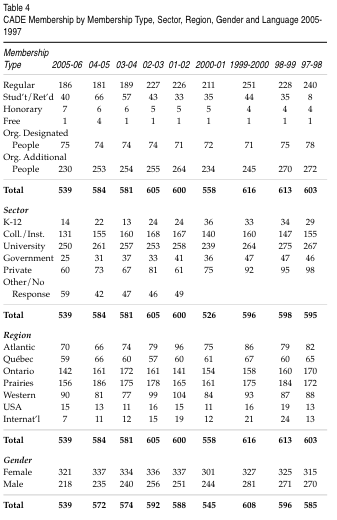
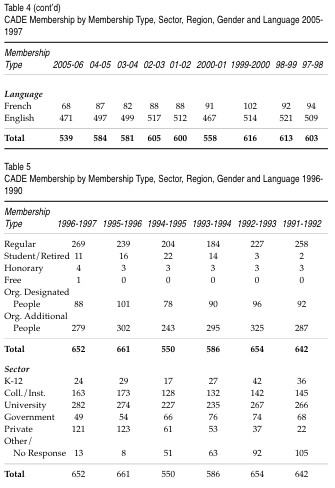
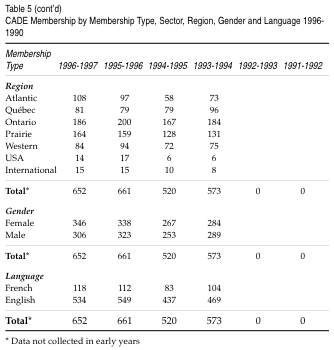
Membership held constant at 600 or more between 1990-91 and 2002-03 except for three years. The declines in 1993-94 and 1994-95 were attributed to the extensive budget cuts at many postsecondary institutions. However, numbers have continued to decline in the last three years. The fairly consistent decline in membership since 2000 is ironic. The more CADE succeeded in gaining acceptance for DE and the more DE was mainstreamed by all sectors, the less important it was seen to be to join CADE because other professional associations were including DE in their deliberations and professional development activities.
In terms of the composition of the membership, some key patterns should be noted. There is reasonable regional representation but it is almost entirely Canadian with much smaller numbers of US and international members. Francophone members have always formed a minority in CADE. Their number rose to 118 in 1996-97 but has fallen to less than half that number in 2005-06. However, student numbers have been increasing, possibly indicating the growth of interest in research in the area.
Initially the number of male and female members was about equal but the proportion of women increased in 1995-97 and again in 2001-02 so that today women form almost two-thirds of the membership. Participation from the post-secondary sector has predominated with much lower involvement from the K-12, government and private sectors. Former presidents interviewed speculated that K-12 participation was low because that sector is not structurally suited to participation in a national organization given the Canadian constitution's designation of education as a provincial and territorial responsibility. An additional complication may have been that the K-12 sector was not as actively involved in DE as were other sectors in CADE's early years; by the time the K-12 sector became active in the field, DE was included its own organizations. This has also been true of the post-secondary sector where provincial DE organizations, sometimes attracting K-12 members, have been formed.
A …. feature of CADE has been the dichotomy between the robust community of those who see distance educators as having a role or place in the new pantheon of e-learning, webcentric technology enhanced, laptop enabled, networked blended hybrid learning environment and the lack of growth in CADE's membership. In some respects, we are all distance learners and educators in North America and Europe.
Personal communication, March 17, 2006
Bill Muirhead, President, 2004-05
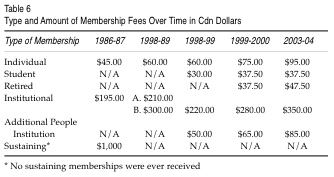
* No sustaining memberships were ever received
Although membership was free in the first year, fees were introduced in the second year. Table 6 shows how the amount and types of fees have changed and the year in which the change was made. For the first 12 years the fees remained the same at $45 for an individual membership. They were increased to $75 in 1999-00 and again to $95 in 2003-04. Institutional memberships were designed to provide a slight reduction for multiple members rather than to be a sustaining membership.
Initially, membership was embedded as an executive level function for which the entire Board was responsible. Based on the agendas and contents of the annual reports, a Membership Committee functioned in 1985-86; committee reports seem to have ebbed and flowed until they disappear entirely as of the May 2000 AGM. The first membership directory was photocopied and distributed in 1983 and annually thereafter until it was put on the web. The Board awards honorary memberships on occasion (see Table 7).
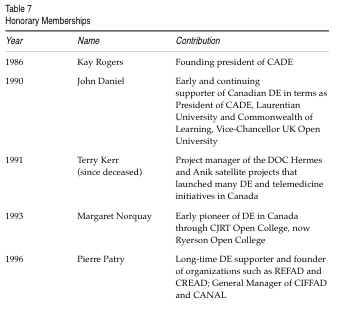
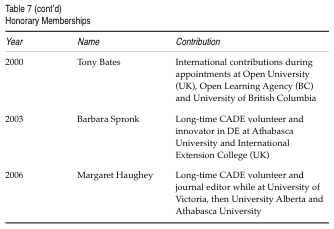
To raise its visibility at conferences in order to recruit members, a three-section stand was produced in 1996-97 and first used at the 1997 ICDE conference at PennState University.
CADE's first reported financial resource was a $350 grant from CAUCE (Annual Report, 1984-85); now, its annual budget ranges from $80,000 to $100,000. Visual inspection of annual reports indicates that memberships have consistently accounted for approximately 50% of revenues, and in-person conferences, especially when large surpluses were achieved in the early years, roughly 22%, with JDE and Other Sources totaling 13% each.
CADE benefited greatly from in-kind support from CAUCE and from the various institutions with which the CADE Board, Journal and newsletter members have been associated as well as those who have provided services such as web hosting and audioconference bridging. Institutions also took out their own memberships in CADE and paid faculty and staff memberships and conference participation. Without such in-kind support, the Association would not have flourished. Indeed, it can be argued that one of the reasons why CADE's growth may have stalled is that institutions had to cut back such support when their own budgets were reduced.
Despite obtaining charitable status, CADE does not seem to have received many donations. The financial statements do not indicate the total amount of charitable donations received to date, but the most recent audited statements presented at the 2005 AGM indicate that CADE received donations of $228 (2004) and $45 (2003).
CADE started in a strong financial position, with a $10,000 GIC at 10.375% interest at the end of its first year as an independent association (Annual Report, 1983-84). By the mid 1970s, the surplus stood at over $100,00 and would have been $27,000 higher had the $27,000 realized from the Moncton conference not been used to fund major changes in publications, public relations and promotions (Finance Committee Report, 1996-97). The Committee noted that the strong financial position depended on averaging $12,000 per year surplus revenue from in-person conferences. The 1998 Banff conference continued the tradition, realizing a profit conservatively estimated at $21,000. However, the 2002 Calgary conference which was done in cooperation with the North American region of ICDE lost a considerable amount of money because of low US registration perhaps due to uncertainty about traveling abroad in the wake of 9/11, 2001. CADE continued as an organization thanks only to Athabasca University's generosity in absorbing the deficit. The 2006 conference experienced a small loss which was shared 40/60 with the host institutions (see Appendix 1) and the CADE/AMTEC partnership respectively. The surplus was drawn down in various years to balance the budget; the 2006-07 budget approved at the May 2006 AGM envisaged a deficit of just over $42,000.
The Business Plan (2004) recommended keeping a reserve of approximately $35,000 (i.e., 50% of the operational budget) to ensure that sufficient funds are available at all times for the effective operations of the Association and to permit an adequate amount for winding down the business in the event that the Association ceases to exist. An additional reserve of $35,000 was recommended in the Plan to provide an advance to the host of a face-to-face conference or to ensure that CADE could absorb a financial loss on a conference. Subsequently, the Board decided to ensure that there was a sufficient surplus to cover an advance or absorb a loss (personal communication, Anna Sawicki, May 27, 2006).
CADE founders highly valued inclusiveness and functionality in both French and English; “from the beginning, it was decided that CADE would operate (albeit imperfectly) in both of Canada's official languages” (Landstrom, 1993, p.113). Interviewees such as Kay Rogers and Arlene Zuckernick recall that “immediately” after the June 15, 1983 founding AGM (i.e., in the summer 1983), they met with stakeholders such as John Daniel (then at Concordia University in Québec) and Jacques Fournier (at the Télé-université) to discuss how to involve Francophones in what had been, to that point, largely an Anglophone group. Kay Rogers wrote Jacques Fournier requesting his assistance in “establishing a vehicle of communication with francophone colleagues in Canada” (personal letter, August 17, 1983). She recalls that she, John Daniel and Jack Gray met with him in Montréal around the time of the August 31, 1983 organizational teleconference meeting; an in-person group met in Montréal for the session, to which M. Fournier was invited.
All publications and formal documents have always been presented in both languages. As the organization grew and resources permitted, professional simultaneous translation for conference plenary sessions was provided. In the early years, some support was received from Canadian Heritage and translation for many sessions was provided by volunteer bilingual CADE members (1986) or by students (1990). However, the Ottawa conference was a watershed, when the organization realized, as a result of a report prepared by Francophone members, that translation had to be planned for and could not be assumed. CADE's service to French-speaking members have continued to be a problem since then, as evidenced by the research results presented in the balance of this section. It should be noted, however, that in exploring the creation of a new national organization, CADE and AMTEC formed a committee specifically to elicit feedback from their Francophone members to ensure that whatever takes shape not only is, but is perceived to be, an organization where Francophones, and the French language, are integral to its operation.
Capacity for Cultural Dialogue
The majority of those interviewed said that they were quoting their Anglophone colleagues in describing how the Francophone spirit has contributed to the development of CADE's openness and capacity for cultural dialogue. Several respondents emphasized the importance of social activities (certain memorable parties come to mind) in facilitating such dialogue. One of those interviewed, whose opinion broadly represents the majority consensus, said:
CADE, at least in the beginning, seemed open to Francophones. Bilingual management; first conference and pro-d session, both bilingual; meetings alternating between the East and the West; workshops in French, etc. The association put in the efforts and personally, I felt fine as a Francophone. However, part of this success should be attributed to the persons who took animation initiatives (for example Thérèse Lamy, Denise Paquette-Frenette, Pierre Pelletier, the people from Téluq, Daniel Larocque, Judy Roberts, etc.) I even remember that for a few years, TVOntario was sponsoring a very useful informal lunch for the Francophones. At the time, the success was related to the flexible and permissive structures (in the positive sense), to friendly Anglophones and energetic Francophones.
The simple fact of asking the question and writing this article, according to several observers, is proof of the wish to give importance to the Francophone reality. From the outset, Francophones were members of the Board of Directors (a little more than 40% of the total jobs on the Board were filled by Francophones over the years, including four Francophone presidents) and the Journal always had French editors. One person commented: “At least the Association tries to respect the importance of the Francophones”. This importance in a Canadian national organization, even as constitutional and identity tensions were raging, is seen as an accomplishment of the dialogue between cultures by some, although others believe it is a perfect example of the concept of the “Two solitudes”.
These two conflicting attitudes are reflected in other comments. One respondent said: “The challenge for the Francophones is to take our rightful place because the opening is there and all Francophones should be encouraged to sit at the table”. Another participant added: “It is very difficult because the Canadian reality is never easy for the Francophones”. The other attitude is surrender: “The Francophones talk to the Francophones and the Anglophones to the Anglophones, very few talk to each other”.
Some respondents add:
“Are the Francophones really interested in what is going on in the rest of Canada? And are the Anglophones interested in what is going on in the Canadian Francophonie? Such questions are typically asked when we participate in CADE conferences and realize that the French presentations are only listened to by the Francophones who don't listen to the conferences in English, because it would reduce the attendance at the presentations of their Francophone colleagues.”
In the context of the amalgamation project with AMTEC, some respondents stressed their feelings of alienation and voiced their apprehensions about the future:
“In summary, we can say that Francophones do not feel welcome at CADE, only tolerated. We succeeded, after an in extremis vote at the general meeting in 2005, in integrating the word “bilingual” in the description of the future CADE-AMTEC association. What will the word “bilingual” really mean in the new association? Since most present members of AMTEC are Anglophones, won't the Francophones feel even more of a minority? Will we have a completely bilingual Web site? Will future conferences offer more bilingual activities? When a conference is organized by a Francophone University, as it is the case in Montréal in 2006, we will probably have more activities in French and a more important Francophone participation, but when the conference is not in Quebec, what will happen”?
Despite such negative thoughts, CADE is considered by everyone as the seminal organization leading to several Canadian successes in distance education. CADE has been important as the first and only networking location for regional development and improvement of distance education specialists.
As a result of the Francophone networking in CADE, “facilitated by Gérard Lafrenière and the Contact Nord [audioconferencing] services”, REFAD (the Francophone distance education network in Canada, an institutionally based organization) “was started”, said one respondent. Some added that the CQFD (the Québec distance education council, an association of professionals) “was born after a difficult CADE conference.” Just as CADE was created after a meeting in the United States, both French associations were created after discussion between Francophones during and after CADE conferences.
CADE is therefore considered historically as an “important and good organization for the development of Francophone distance education,” even if what retains the attention of some is the imperfection identified by Landstrom (1995) that for them became discontent.
In the conversations with Francophone participants, what was questioned most often was the present and mid-term relevance of CADE. This is a time to re-evaluate distance education; for some “the distance education concept is not [even] relevant, so that CADE has no real cause to defend any more.” Some members told us that they had not renewed their membership because they had other priorities; for some, it was because of linguistic reasons.
Several respondents expressed conflicting views on the balance between researchers and practitioners within CADE [also a topic of debate within the Anglophone membership]. Some perceive the Association as being a scholarly association with little relevance to practitioners; “even today [CADE is] a university ploy looking for research subjects.” If so, they say, the Association is not doing a good job because there is no plan or strategy for focused research; it should establish priorities and implement them. Others complain that “CADE is unfortunately not an association of researchers directing and building the future, but an association of people practising a profession.” These divergent views illustrate the multi-faceted nature of the distance education field, and that it is “very difficult to respond to the members' diversity of interests and to be everything to everyone”. That diversity has led to the creation of other, more specialized, associations.
As a solution to this paradox, the importance of cultural dialogue should be emphasized in distance education according to some. A possible basis for future planning is put forward in the following statement:
If everything was going well and if CADE wanted to efficiently and practically promote the popular use of distance education and not only as a subject of conversation between intellectuals “because it is such a nice research subject”, the following facts would still be true: the priorities are not the same; Franco-Canadians don't have to deal with the Americans with the same precision as Anglo-Canadians. There will be at least two strategies and two plans of action. For me, CADE can be a link to both cultures: certain relevant Francophone activities for the Anglos concerning their strategy, translated and explained, some relevant Anglophone activities concerning their strategies translated and explained for the Francophones, and some new ones available to all, all that in a shared strategy. Then we have an association with a reason for existing and knowing why it does what it does. To me this seems so far from the present reality that I am not even sure if they even want it. They seem so comfortable.
In conclusion, one respondent nicely summarized the feelings of the great majority of those interviewed:
CADE, with or without AMTEC, has a brilliant future if its members and leaders stop constantly looking at the national scene and take a closer look at distance education. CADE must take every opportunity to promote distance education, in cooperation with the other associations, provide services to the members such as the Journal, networking and professional improvement and finally revive the spirit of collegiality and the openness of DE pioneers such as Jacques Fournier and Pierre Patry, who often repeated: “May the gods be with you!”
From its very earliest days, CADE envisaged itself as engaging in the international DE community. John Daniel, President of ICDE in 1983, conveyed greetings from ICDE at CADE's first AGM June 15, 1983 and recently shared his thinking about the Association’s international profile:
The Canadian distance learning community punches above its weight internationally for several reasons. First, because of its long distances Canada was an early player in correspondence education at school and university levels. Second, as a technologically advanced country it has been at the forefront of modern developments such as satellite communications and eLearning. The third and most important reason, however, is that unlike the USA, which for a long time treated distance education as synonymous with remote-classroom teaching, Canada followed the rest of the world in defining it in terms of asynchronous learning. This meant that Canadians were effective contributors to the discourse on distance education in both the USA and the rest of the world.”
Personal communication, March 16, 2006
Sir John Daniel, President, 1988-89
Started in Washington, CADE has continued to maintain close ties with colleagues in the United States. In its early years, CADE members were often at PennState University for various events organized under Michael Moore's leadership, including an ICDE meeting held there in 1997. The annual Teaching and Learning in Distance Education conferences at University of Wisconsin have also been crucial events for many Canadian practitioners and researchers. The two comments below indicate how contacts have evolved.
I was first "introduced" to CADE through my association with Athabasca University and the late Dan Coldeway. Athabasca was one of the models used in the development of the University of Texas System TeleCampus, and it was during my visits there that I came to appreciate the distance learning advancements across all of Canada …[and] that the people responsible for these advancements were part of CADE.
Personal communication, March 15, 2006
Dr. Darcy Hardy, University of Texas System and Chair
Emerita,
United States Distance Learning Association
I have been a member of CADE for nearly ten years …. CADE remains at the forefront of the profession through its scholarly dissemination of the Journal of Distance Education and its international conference. …. CADE …. makes a deliberate and spirited effort to connect “research with practice” that ultimately expands the frontiers of knowledge in the distance education field…. Improves practice, highlights the unique work of faculty, and provides managers and leaders with a broader arsenal of strategies to improve distance education quality and excellence for students. … CADE's ultimate focus has remained where it should … on our distance learning students. Technology, in and of itself, it simply a tool. Nothing more, nothing less.
Personal communication, March 19, 2006
Dr. Don Olcott, Jr., President-Elect United States
Distance Learning Association, Western Oregon University
Yet another perspective is offered from Latin America. CREAD, a tri-lingual organization, cooperated in two Vancouver conferences, organizing its own conference and AGM back-to-back with CADE's 1994 Vancouver conference and collaborated in a University of British Columbia workshop in 1999:
I … have seen CADE from two perspectives …. One perspective was from Latin America when I was a practising distant educator there [Note - the ICDE conference held in Caracas in 1990 was attended by many CADE members]. I was very impressed by the good work that CADE was doing …. in promoting the use of distance education in Canada and fostering research and scholarship in this vast country. My other perspective has been from CREAD. CADE as an organization and several of its members as individuals have been very supportive of CREAD and its mission. That considerable level of support is recognized by the Consortium's Latin American members and I hope that we will be able to undertake more common activities and projects in the near future.
Personal communication, March 20, 2006
Armando Villarroel, Executive Director, CREAD, Inter-American Distance Education Network Consortium-réseau d'éducation à distance
CADE sought to involve itself internationally in a number of ways. Conferences are marketed internationally, and are now always labeled as “international” to facilitate participation by overseas delegates. As noted in other sections, CADE has co-sponsored conferences with international organizations such as ICDE and COL. Joint membership with ICDE was pursued for a number of years but could not be achieved to the mutual satisfaction of the two organizations.
In addition to these contacts with colleagues in similar professional organizations around the world, CADE has engaged in activities such as attending meetings and consultations organized by organizations such as UNESCO, the Organization for Economic Co-operation and Development (OECD) and the US National Center on Adult Literacy (February 14-16, 1996 in Philadelphia).
You can’t step twice into the same river..
Héraclitus
The CADE and AMTEC memberships have voted to create a new organization that reflects their beliefs and values. While many might think that the relationship with AMTEC is something new, it is not. The agendas for both the May 1988 and 1990 AGMs include greetings from AMTEC and CADE's constitution was modeled on AMTEC’s:“Alone we can do so little; together we can do so much” (Helen Keller), is a fitting quote about teamwork, which I believe is the underlying strength of CADE.
Personal communication, April 22, 2006
Dr. Norm McKinnon, President, 1991-92
One of the key tasks performed in 2005-06 was to address the mission and goals of such an organization. Joan Collinge noted in her interview that the process of holding discussions with AMTEC has led to the realization of how important our values and philosophy are to us and how we use language: “We are all in it together? What is it? It equals education. It equals access. Those words mean different things to different people.” She cautioned that adopting DE practice in an ahistorical context can mean failure not success, especially if values and practice are not aligned. She felt that the new entity should preserve CADE's power for collegiality and sustenance, especially for the lone practitioner who does not have a local critical mass of colleagues:
If I learned anything during the year I was president, it was that people care passionately about distance and open education and the values associated with those concepts. They are not concepts driven by modes of delivery. Rather they determine the appropriate mode of delivery … the correct choice being whatever ensures access to learning in whatever part of the world or socio-economic context we are working. That was the joy that sustained me.
Personal communication, July 4, 2006
Joan Collinge, President, 2005-06
In one sense, CADE has succeeded beyond the wildest dreams of that visionary band who met in a hotel room in Washington DC in 1983. Blended learning is now seen as conventional, accepted practice by many stakeholders. In another sense, blended and flexible learning are perceived as becoming so dominant that the need for, and values of, distance educators are being lost. Hence, despite the adage not to design the future based on a model from the past, we end this historical review with a clarion call to remember the important, and sometimes painful, lessons of the past 25 years. We leave it to two former presidents, each in their own language, to express it best:
While a focus on the newest technologies or communications politics is understandable for a new professional organization, its members will require professional confidence, resources, and the courage of deeply-held convictions to sustain equity of access, context-relevant learning designs and resources, unabashedly critical analyses of practice, and respect for past experience … . We must be acutely and holistically aware of all contexts in which we operate, especially in today's fast pace.
Personal communication, March 16, 2006
Liz Burge, President, 1996-97
Tous les professionnels oeuvrant en formation à distance doivent défendre avec passion les valeurs qui sont associées à la formation à distance : l'accessibilité pour tous et toutes, des technologies conviviales et une pédagogie qui favorise l'exercice de l'autonomie des apprenants.
Personal communication, March 16, 2006
Thérèse Lamy, President, 1993-94
Board of Directors, Orientation Guide, May 2005
CADE/ACÉD: The First Twenty Years (included in 2002-2003 Annual Report)
Burge, E.J., Roberts, J.M., & Waldron, M. (1984). Audio-teleconferencing in continuing education: A case study with implications. Canadian Journal of University Continuing Education, X(2), 20-30.
Distance learning process and materials design. Proceedings of the First National Workshop of the Canadian Association for Distance Education. April 25-26, 1984. Toronto: ACÉD/CADE, 117 p.
Council of Ministers of Education, Canada, Office of Learning Technologies, Government of Canada & Institut pour la promotion de l'éducation à distance, Télé-université. (1999). Open learning and distance education in Canada. Canada. Faille, C., & Umbriaco, M. Report presented to Asia-Pacific Economic Cooperation Education Forum Project.
Landstrom, M. (1993). CADE: The first ten years. Journal of Distance Education/Revue de l'éducation à distance, 8(1), 113-118.
Roberts, J.M., Gallant, G., Keough, E. M., & Zuckernick, A. (2005). CADE/ACÉD & AMTEC: Moving forward together. Report presented to the Boards of Directors. Available http://www.cade-aced.ca
Rogers, K. (1984, July) Letter to CADE members and a 2-page report entitled CADE ACTIVITIES FOR 1984-85 INCLUDE :
Rogers, K. (1984, June). Canadian Association for Distance Education 1983-84 Report to the Canadian Association for University Continuing Education.
Willment, J. (2003). Leading innovation: CADE National strategic consultation.
We are enormously grateful to everyone we contacted and/or formally interviewed in preparing this article. All gave most generously of their time to support CADE. All presidents interviewed are listed in Appendix 2. Francophone interviewees are listed as follows:
Dominique Abrioux Université Athabaska
Marquis Bureau Cégep@distance
Jean-Benoît Caron Université Laval
Pierre Gagné TÉLUQ-UQÀM
Raymond Guy Collège Boréal
France Henri TÉLUQ-UQÀM
Denys Lamontagne THOT/CURSUS
Thérèse Lamy SED Enrg.
Alain Langlois REFAD
Daniel Larocque PENSIVO
Céline Lebel TÉLUQ-UQÀM
Lucie Lavoie TÉLUQ-UQÀM
Claire Mainguy Université Laval
Denis Mayer Université Laurentienne
François Pettigrew TÉLUQ-UQÀM
Claude Potvin Université Laval
Noël Thomas PENSIVO
Denise Vigneault Université Laval
Special thanks to Anna Sawicki, the Board member who took the lead on this project, Tim Howard in the Secretariat, and the translator Denyse Demers.
A disclaimer and apology are needed. People's memories are understandably different about various events mentioned in this article; sometimes, a document or issue of a newsletter was missing. So, if we have made errors of commission or omission, we heartily apologize. They are ours, not those who helped us research this article.
We thank CADE for this opportunity to re-connect with colleagues. It was a distinct pleasure to be given the chance to share precious memories of our time together over the years. And a privilege to receive permission to almost double the length of the text in order to more fully describe what CADE has meant to its members.
Judy Roberts has been a member of CADE since its first audioconference meeting June 15, 1983. When not volunteering for the organization, she has worked in telemedicine and distance education projects in Newfoundland and Labrador and Ontario. For the last several years, she has been an independent consultant in the appropriate use of information technology in learning and training, specializing in strategic, business and project planning and evaluation. A member of the editorial board of peer-reviewed journals, she also holds adjunct faculty appointments and teaches online in Canadian and international graduate programs.
Michel Umbriaco has been associated with CADE since its inception. One of the founders of the Télé-université, he has held numerous positions there over the past thirty years. Professor of graduate courses in distance education and educational management, his publications are mainly in the domains of distance education, technology and development.
